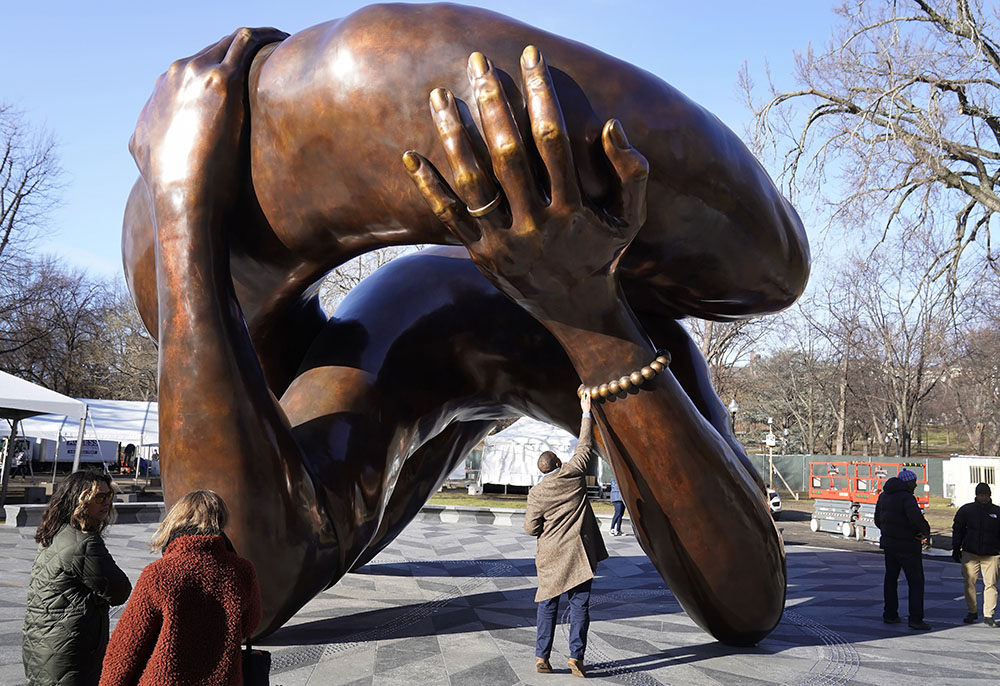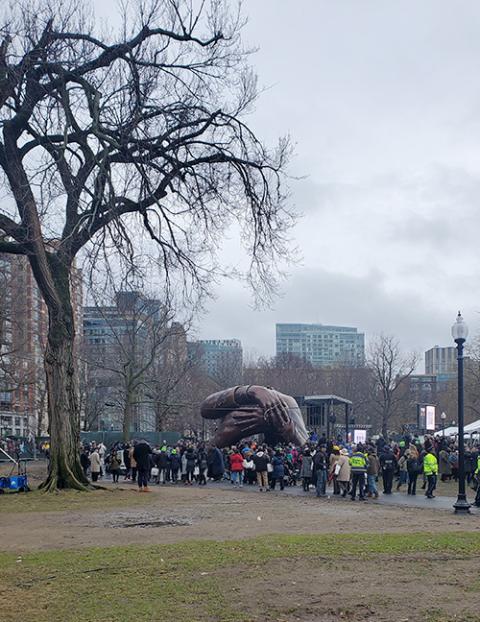
A man reaches to touch a detail of the 20-foot-high bronze sculpture "The Embrace," a memorial to Dr. Martin Luther King Jr. and Coretta Scott King, in the Boston Common Jan. 10 in Boston. The statue was officially unveiled during ceremonies Jan. 13. (AP/Steven Senne)
On Friday, Jan. 13, a new sculpture honoring the late Dr. Martin Luther King Jr. and his wife, Coretta Scott King, was unveiled in the Boston Common. Standing over 20 feet tall and 40 feet wide, the bronze sculpture depicting a joyful embrace following the announcement that Dr. King was being awarded the Nobel Peace Prize has been met with praise for its innovative concept and much maligned for everything from its disembodiment of the figures to confusing perceptions of what one is seeing when they look at the statue from various angles.
What was lifted up for weeks on the local news in Boston and nationally as a beacon of hope and a monument to love is now facing the question: "Will the public embrace 'The Embrace'?"
Making my way to the Boston Common — the United States' oldest public park — on the morning of the unveiling, the divisive maelstrom yet to come was the furthest thing from my mind. Emerging from the "T" (Boston's subway system), I found myself immersed in an atmosphere of excitement. Despite rainy weather that gave way to overcast skies, crowds gathered in anticipation of the unveiling.
Like many of my fellow onlookers, I was surprised to find the monument and grandstand for the celebration quartered off by metal fencing covered in opaque material. We all apparently had missed the memo that the ceremony was by invitation only and yet as crowds assembled both inside and outside the designated 1965 Freedom Plaza, a celebratory spirit filled the air.
This project, after all, had been a community effort. While "The Embrace" was the vision of artist Hank Willis Thomas, executed in concert with the MASS Design Group, the larger project that led to this day was a yearslong effort of consultation, community-building and consciousness-raising.
Advertisement
Beginning in 2017 with the intent of honoring the Kings, whose relationship began in Boston and whose civil rights work returned them to the city over the years, the nonprofit organization Embrace Boston solicited financial backers for a memorial and engine of social change in the city (with projects reaching far beyond the memorial to affect change in neighborhoods historically underserved in Boston).
That same year, the organization put out a call for artists that yielded hundreds of proposals for a monument. Eventually the field was narrowed to five candidates by the memorial's sponsor, and with public input, Thomas' "The Embrace" was ultimately selected to be erected in the Common.
Positioning myself on an incline overlooking the day's festivities, I watched as people dressed in suits and skirts mingled with those in destressed denim and sneakers. Everyone had gathered for this momentous occasion. No rain or restricted views could dampen spirits. The fabric on the fences was soon torn down by onlookers, so that despite the metal fence they too could have a vision of the monument.
As bands began to play and politicians gave speeches in commemoration of the Kings and their legacy, I watched as parents ushered school-aged children up to the fences, the closest onlookers making way so that the littlest could have a front row (or at least fence) view of the proceedings.
The thing that was most palpable, though, about the day was a sense of Black joy. Embrace Boston's vision statement commits to "a radically inclusive and equitable Boston where everyone belongs and Black people prosper, grounded in joy, love, and wellbeing."
Joy isn't something you can fabricate. It comes naturally from the heart. Joy rises out of freedom, liberation, fullness.
"The joy of Black faith is a people coming together, praising and saying hallelujah to a God that is freedom," the Rev. Kelly Brown Douglas told Kidada Williams on the podcast "Seizing Freedom." "Because to me that is an affirmation of life in the face of death. It's God's 'No!' to anything that would deny Black life."
This joy is a resistance. It has the last word and it calls forth justice, so that all may be free.
As I listened to the speakers at the unveiling of "The Embrace," the words of Jha D Amazi, a principal partner in the MASS Design Group that helped bring the statue to life, resonated with me.

From outside the fence line, a view of "The Embrace" at its unveiling Jan. 13 (Colleen Gibson)
"It has been very hard for me as a daughter of Boston to maintain composure and not bawl," Amazi told the crowd gathered. "This is such a beautiful moment for me as a person but then you add the layers and the intersectionality of my Blackness, of my womanhood, of again me being a native of Boston and then to be offered the opportunity as a architect, as a young Black architect educated in this city to participate in a moment like this where we honor the Black experience, Black joy, Black love, in the oldest park in the country."
That joy and love were freely wafting in the air.
"I am reminded that we are called to do this work. And — this y'all — this is on purpose. This is on time. This is on our shoulders."Amazi concluded.
In this moment, the call was clear — it was a call to joyful embodiment, freedom and resistance. Here, a community had come together for the good of the whole. The beloved community that the Kings advocated for throughout their lifetimes was made manifest then and there. Was it perfect? No. But there was union in purpose, solidarity in joy, and hope in community.
As Coretta Scott King wrote, "To me, the Beloved Community is a realistic vision of an achievable society, one in which problems and conflict exist, but are resolved peacefully and without bitterness."
This community works to eliminate poverty and hunger, bigotry and violence, for the sake of all.
To attain this Beloved Community requires that enough people commit to education and training, courage and sustained action, especially those in the white community. It requires embracing joy and recognizing that our joy is only complete when it is joined with the joy of others, those who are oppressed, and with God's joy.
Amid the debates over the design of "The Embrace" as a monument — its figural exclusion of the Kings' faces, its perceived diminishment of their radical message to one of simple love, and challenge of perspective to the all-encompassing vantage — it would be a shame if the gifts of community that went into its creation and the joy it encapsulates were lost.
That is the joy with which the Kings embraced originally when Dr. King won the Nobel Peace Prize. That joy is tied to justice, to the love of God active in the world and in the Kings' relationship. Sustaining joy and justice are our call today.
As Martin Luther King declared at the end of his Nobel Lecture in 1964,
I am not yet discouraged about the future. Granted that the easygoing optimism of yesterday is impossible. Granted that those who pioneer in the struggle for peace and freedom will still face uncomfortable jail terms, painful threats of death; they will still be battered by the storms of persecution, leading them to the nagging feeling that they can no longer bear such a heavy burden, and the temptation of wanting to retreat to a more quiet and serene life. Granted that we face a world crisis which leaves us standing so often amid the surging murmur of life's restless sea. But every crisis has both its dangers and its opportunities. It can spell either salvation or doom. In a dark confused world the kingdom of God may yet reign in the hearts of men.
If we can embrace that vision of a love that does justice, God's joy will be alive in us, dwelling in our embrace of all that is broken, so that all — ourselves and our world included — may be free.





